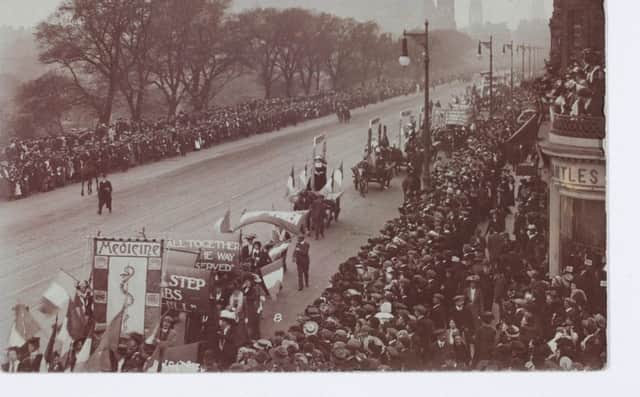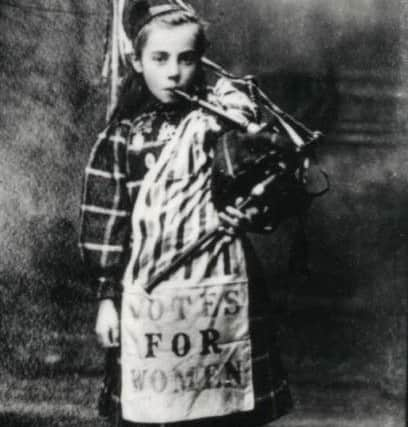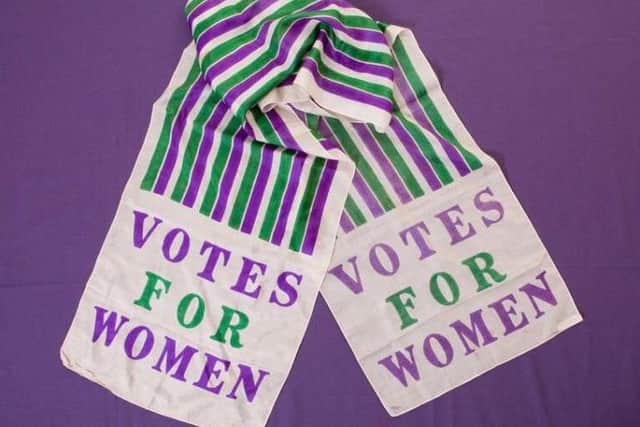100 years on: Celebrating Edinburgh's suffragettes


Back then, suffragettes up and down the country would stop at almost nothing to get their voices heard in parliament. The struggle to win the vote was long and arduous, but in 1918 these brave women won.
Since then, women around the world have channelled the suffragette spirit to campaign for progress. They have stood up to racism, sexism, homophobia, corruption and much more.
Advertisement
Hide AdAdvertisement
Hide AdLast century’s suffragettes are today’s women human rights defenders. Every day they harness their passionate voices to empower communities and create a fairer world.


Amnesty International campaigns to help protect women human rights defenders around the world. These brave campaigners often face surveillance, intimidation, threats, imprisonment and some even risk their lives. But you don’t need to travel thousands of miles to meet women fighting for justice and equality. In fact, there’s probably a woman human rights defender living at your doorstep.
This is why Amnesty and this newspaper want readers to nominate the incredible women who are making a real difference in their local area. Ordinary women from all walks of life — from students to shopkeepers, office workers to OAPs — are doing extraordinary things.
They might have stood up to bullies, helped the homeless, aided refugees, worked to protect the environment or campaigned for better access to healthcare. The list goes on.
Advertisement
Hide AdAdvertisement
Hide AdEvery time these women have spoken up, they’ve helped make life better for others — to ensure that you and I, as well future generations, enjoy a fairer, more equal world.


The amazing achievements of these often-unsung heroes deserve to be celebrated, and Amnesty wants to put them on its Suffragette Spirit Map of Britain.
The interactive map, which will launch on International Women’s day, will be a symbol of the suffragette legacy — proudly displaying how far we have come over the past century, but highlighting how much life-changing work is still being carried out today.
So, over to you: Which 21st century suffragette deserves to be put firmly on the map?
Edinburgh caught up in women’s struggle for equality


Advertisement
Hide AdAdvertisement
Hide AdBefore 1918 women had almost no role in British politics – they didn’t even have the right to vote. A woman’s role was domestic, encompassing little outside having children and taking care of the home. The suffragettes changed this.
The 19th century was an era of massive change. The Industrial Revolution and numerous reforms, including the abolition of slavery in 1833, saw society changed forever. Women did see some progress – in 1859 the first female doctor was registered, in 1878 women could graduate from university, and in 1882 women were allowed to keep inherited property and wages. But they still couldn’t vote.
Campaigns for women’s rights, including the right to vote, started around the mid-19th century, after Mary Smith delivered the first women’s suffrage petition to parliament in 1832. But it wasn’t really until 1897, when Millicent Fawcett founded the National Union of Women’s Suffrage Societies, that the campaign for women’s suffrage really gained momentum.
These campaigners were known as suffragists and they believed debate, petitions and peaceful protest were the keys to success. But the suffragists failed to get results, and many campaigners decided a more militant approach was required.


Advertisement
Hide AdAdvertisement
Hide AdIn 1903 Emmeline Pankhurst and her two daughters Christabel and Sylvia, set up the Women’s Political and Social Union in Manchester with its slogan “deeds not words”. These women became known as suffragettes and soon made headlines up and down the country.
Suffragettes were a shock to Edwardian society. They interrupted political meetings, chained themselves to railings, yelled while waving banners emblazoned with VOTES FOR WOMEN, were regularly arrested, went on hunger strike, cut phone lines and one, Emily Davidson, threw herself under a racehorse to get the suffragette message heard.
But the suffragettes’ fight paid off. In 1918, the Representation of the People Act was passed, giving women over the age of 30 who owned a certain amount of property the right to vote, along with all men over 21. It would be a further ten years until the vote was extended to all women, when the Equal Franchise Act was passed, but it was a major step in the right direction for the movement.
The fight for rightful suffrage for women did not evade the Capital and the vein of political action ran from rallies to rousing speeches to criminal activity.
Advertisement
Hide AdAdvertisement
Hide AdSo desperate were the city’s women to draw attention to their cause, many served prison terms for public disturbance.
And one story, which remains unsolved to this day, saw a woman, suspected to be a suffragette, set off a bomb at the Royal Observatory.
On May 21, 1913, the attack was reported to have taken place at 1am in which “the perpetrators left behind them a ladies’ handbag of the kind used for shopping. It contained a few currant biscuits wrapped in paper, a couple of safety pins, and in the grounds were found two pieces of paper” – one read “How beggarly appears argument before defiant deed. Votes for women.”
Another suffragette, Maude Edwards, who had attempted to draw attention to Mrs Pankhurst’s failed attempt to lead a deputation to the King at Buckingham Palace, was tried at Edinburgh Sheriff Court on Friday, July 3, 1914. She was convicted and imprisoned after being found guilty of slashing John Lavery’s portrait of King George V on display at the Royal Scottish Academy in Edinburgh.
Advertisement
Hide AdAdvertisement
Hide AdThe centre of Edinburgh was also the setting for a suffragist demonstration in October 1909, which drew “an enormous crowd”. It was described in The Scotsman as an “afternoon that will be remembered as a great success”.
And now, a century after the hard-fought battle to have the voices of women across the country heard, is doubtless worthy of celebration.
But 100 years on, the voices may be louder but the accomplishments of the Capital’s women over the centuries, their stories remain hidden – tucked away only to be unearthed on an anniversary or when a local group takes an interest. Our public gardens, streets and thoroughfares are packed with proud reminders of the city’s history – they’re just all men.
The Evening News has launched a £50,000 fundraising drive to secure pioneering suffragist Elsie Inglis a statue in the city that she so rightly deserves.
Advertisement
Hide AdAdvertisement
Hide AdIt will not only recognise her personal medical achievements, including setting up the Scottish Women’s Hospitals during the First World War, but will stand as a mark of the enduring impact of her selfless dedication to both the betterment of health and to securing votes for women.
During the First World War, hospitals were staffed solely by women to help the Allied war effort on the frontline, with Churchill lauding Dr Inglis as a heroine that “will shine in history”.
Dr Inglis also established a medical college for women in the Capital – after she become one of the nation’s first female doctors.
The Evening News’ campaign was launched with the support of Capital-based charity, One City Trust – which fights inequality and exclusion. Lord Provost Frank Ross, president of One City Trust, said there was no better time to push ahead and secure a statue to honour Dr Inglis.
Advertisement
Hide AdAdvertisement
Hide AdEdinburgh has more statues of animals than it does of women. The lack of heroines immortalised in stone or bronze is only made more apparent by the stark contrast when it comes to their male counterparts. In 2016, members of Women In Focus In Edinburgh (WIFIE) sought to highlight this imbalance, erecting five blown-up photos of notable Edinburgh women – one of them Dr Inglis.
HOW TO NOMINATE
To nominate an amazing woman in your local area, please visit www.amnesty.org.uk/suffragettespirit. All women must have carried out work to help others in their local area within the last 10 years.
All successful nominees will be contacted to give consent prior to being placed on the Suffragette Spirit Map of Britain.
This campaign has been funded by People’s Postcode Lottery.